Hello! So today I thought I would inform you all on some more of the things I learned. As you may remember the program connected three museums, the one in Chile is known as Villa Grimaldi. On our first day we took a tour of the museum, which I would more accurately call a park. Here is where I was taught my basis of the human rights violations that occurred in the 1970s. Basically Salvador Allende was democratically elected by the people in 1970. However he was considered a socialist. A select group was against this, so in 1973 a coup was organized to overthrow him. That day Allende supposedly shot himself and a man named Augusto Pinochet rose to power. Under his more than a decade long presidency about 3,000 people were killed, another 40,000 people tortured and a total of 80,000 people were interned by his regime.
Villa Grimaldi had been a restaurant, but after the take over was turned into one of the biggest torture facilities of the country. As we walked around this place, the full gravity of its significance began to hit us as we were told its history. It has now become a place of memory in order to never allow people to forget what happened there. After the more terror oriented side of the regime ended, Pinochet ordered the destruction of the Villa so that citizens wouldn’t know what happened there. Now only some recreations of the structures exist, based off of survivor accounts and a few photographs that existed. But, for the most part the lot is filled with memorials to beautify and remember the people that were there.
Half way through the tour we found out that one of our guides had in fact been a survivor. Her testimony was immensely moving as she described the cells that people were kept in, and the sadistic torture people there endured- including electric shock and mutilation. Every day prisoners would hear the screams of the tortured and would see the dead being taken away (many whose bodies were never found). She told us briefly how her husband and her newborn son were among those killed while there. We were informed how not everyone there had been Allende supporters, or even socialists, many were simply outspoken people in communities whose absence/torture would force many others into submission even if they weren’t tortured. We were shown the block where women specifically were held, where collective rapes were preformed. However instead of focusing just on this, our tour guide described to us in great detail how everyone looked after each other, and how communities formed among the women. To this day some people who survived meet once a month to stay in touch with each others lives. This was probably the most interesting part, on the one side this place was filled with so many memories of hurt and torture but on the other it had many instances of compassion. She told us stories of remarkable people who risked their lives to clean one another’s clothes, to relay information of loved ones and overall to protect each other.
All this information was a lot to take in. And after we dialoged about our thoughts of the tour. But one thing that really stuck with me, that many people don’t know, is that the US played a part in all this. Our government helped ignite the coup and backed the regime when it was in power. A school here, once known as The School of the Americas, even taught people how to torture. After this whole day of learning about the tragedy that occurred in Villa Grimaldi, only one of the thousands of torture facilities, learning this piece of information that the US didn’t stop it, that we almost encouraged it, was a devastating blow to us “Ambassadors of the US”. Facing survivors, who were held by American taught torturers, was extremely hard. I wanted to convey that not all Americans are like that, that many do not support the foreign decisions of our government. But I cannot take back what happened there, I can only accept the facts they gave me and resolve personally to not stand by as something like this occurs again. Overall, Villa Grimaldi was more than just an influential part of my trip, and I am so glad that I learned everything I did there. Some say ignorance is bliss, which I can understand. Many wouldn’t want to learn about the atrocities that were committed there. But with the information, I feel I have become a stronger person because of this new found sense I have of the past, other cultures and the world today. My only hope is that I can inform about what happened there and help make a positive impact on others in the future.
Villa Grimaldi had been a restaurant, but after the take over was turned into one of the biggest torture facilities of the country. As we walked around this place, the full gravity of its significance began to hit us as we were told its history. It has now become a place of memory in order to never allow people to forget what happened there. After the more terror oriented side of the regime ended, Pinochet ordered the destruction of the Villa so that citizens wouldn’t know what happened there. Now only some recreations of the structures exist, based off of survivor accounts and a few photographs that existed. But, for the most part the lot is filled with memorials to beautify and remember the people that were there.
Half way through the tour we found out that one of our guides had in fact been a survivor. Her testimony was immensely moving as she described the cells that people were kept in, and the sadistic torture people there endured- including electric shock and mutilation. Every day prisoners would hear the screams of the tortured and would see the dead being taken away (many whose bodies were never found). She told us briefly how her husband and her newborn son were among those killed while there. We were informed how not everyone there had been Allende supporters, or even socialists, many were simply outspoken people in communities whose absence/torture would force many others into submission even if they weren’t tortured. We were shown the block where women specifically were held, where collective rapes were preformed. However instead of focusing just on this, our tour guide described to us in great detail how everyone looked after each other, and how communities formed among the women. To this day some people who survived meet once a month to stay in touch with each others lives. This was probably the most interesting part, on the one side this place was filled with so many memories of hurt and torture but on the other it had many instances of compassion. She told us stories of remarkable people who risked their lives to clean one another’s clothes, to relay information of loved ones and overall to protect each other.
All this information was a lot to take in. And after we dialoged about our thoughts of the tour. But one thing that really stuck with me, that many people don’t know, is that the US played a part in all this. Our government helped ignite the coup and backed the regime when it was in power. A school here, once known as The School of the Americas, even taught people how to torture. After this whole day of learning about the tragedy that occurred in Villa Grimaldi, only one of the thousands of torture facilities, learning this piece of information that the US didn’t stop it, that we almost encouraged it, was a devastating blow to us “Ambassadors of the US”. Facing survivors, who were held by American taught torturers, was extremely hard. I wanted to convey that not all Americans are like that, that many do not support the foreign decisions of our government. But I cannot take back what happened there, I can only accept the facts they gave me and resolve personally to not stand by as something like this occurs again. Overall, Villa Grimaldi was more than just an influential part of my trip, and I am so glad that I learned everything I did there. Some say ignorance is bliss, which I can understand. Many wouldn’t want to learn about the atrocities that were committed there. But with the information, I feel I have become a stronger person because of this new found sense I have of the past, other cultures and the world today. My only hope is that I can inform about what happened there and help make a positive impact on others in the future.
Included above are just a couple pictures of Villa Grimaldi. The tree picture is the size of a cell block that would include about 6 cells each with 4-5 people shown in the next two pictures. They were designed to weaken the prisoners before torture. Many people spent days on end within them without food and water. Throughout the park mosaics represented certain areas that had been destroyed. The one I included was a place that contained metal bed frames in which people were forced to lie down on and be electrocuted. The stone wall included the names of people who were last seen at Villa Grimaldi before disappearing. It was organized by year and there was a space after each year for more names to be added for as more information comes out, or remains are found of people who were killed at Villa Grimaldi. For example in 2012, 13 bits of peoples remains were found off a cliff near by. They were identified as killed at the Villa, and were added to the stone wall. Many families visit the wall to find the names of their loved ones. Also on the wall one can see fossils, which represent how the past can still be seen and effect the future. The rose garden was built to honor the memory of the 900 women and counting, who were killed there (only 15% of the victims there and generally forgotten about). Next the Tower is the reconstruction of the main torture building. About 90% of the people who went there never came out. Our tour guide was not only a woman but one of the 10% who survived the Tower. People were held in dog sized cubbies in wall in the upper levels of the Tower as they waited their turn to be tortured. Lelia our tour guide took us to see one of the small cubbies on the second level. Lastly the pictures were some of the faces of people killed. They were in another house next to the Tower, one of which that was solely built for the individual memorials of victims.



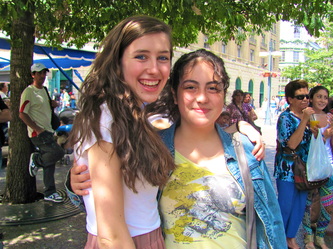


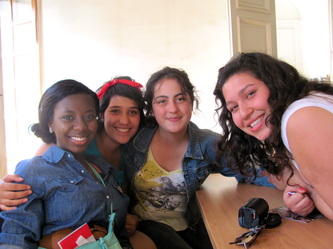


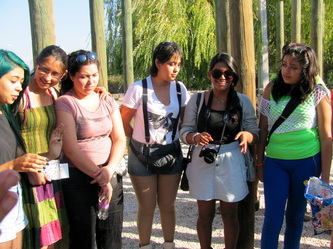
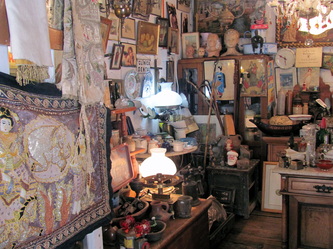
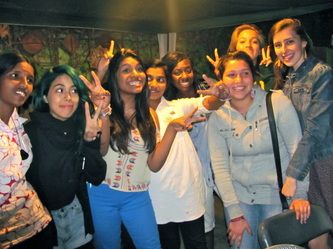
 RSS Feed
RSS Feed